A friend of mine refers to cycling as ‘the fountain of youth.’ If you think about it, cycling does help you stay youthful.
It works your cardiovascular system, helps you have more energy, is easy on the joints, and builds muscles.
In this article, we will focus on how cycling works muscles. We’ll talk about what muscles cycling tones, the differences between male and female cycling muscles, and the differences between running and cycling muscles. Let’s get started.
Key Takeaways
- Cycling tones muscles boosts energy, and benefits the cardiovascular system.
- Lower body muscles like quads, hamstrings, and glutes are primarily worked during cycling.
- Different cycling disciplines emphasize different muscles.
- Cycling also works the core and upper body muscles.
- Cycling and a healthy diet aid weight loss, while weight training off the bike improves muscle balance and metabolism.
What We Mean by Muscle Tone
When we talk about muscle tone, most people refer to how their muscles look. When they want to tone up, they want to lose fat and develop muscle simultaneously.
So in layperson’s terms, toning your muscles is about making your muscles stronger, bigger, and more defined.
If you have a higher level of body fat, you won’t see your muscle definition no matter how much you work them. And you can’t ‘spot reduce’ fat in areas you work on toning, either.
The good news is that cycling and a healthy diet can help you lose weight and body fat to show off your muscle definition.
You’ll build muscle and look more toned as you lose fat through cycling.
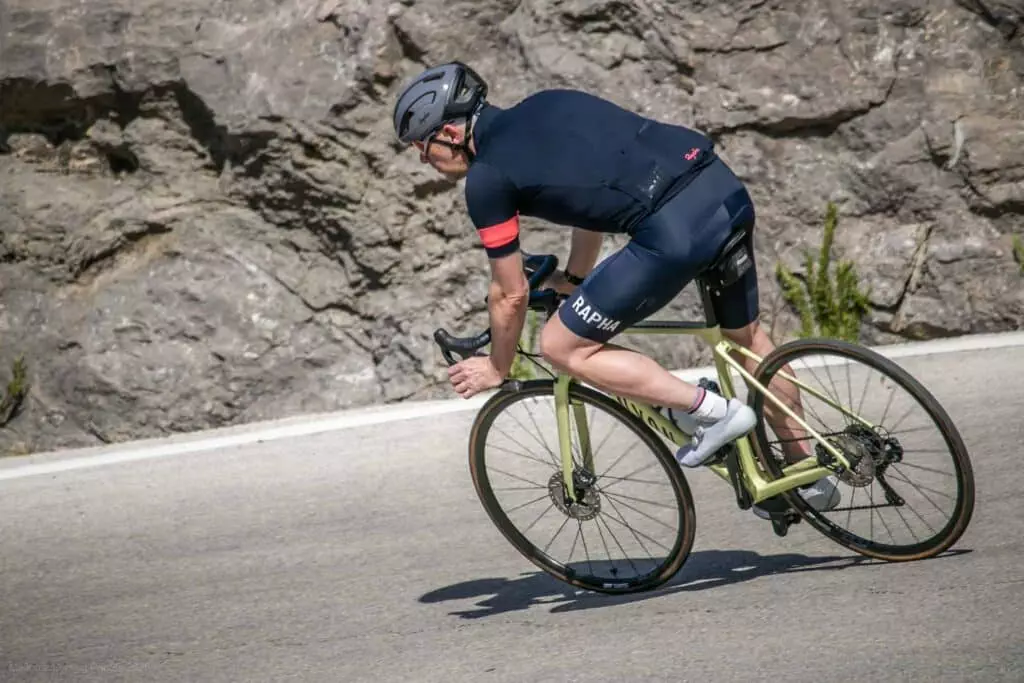
What Muscles Does Cycling Tone, or More Accurately, Work?
When riding a bike, you use your muscles to put power to the pedals and to balance. The larger part of your cycling power comes from your lower body, while muscles for balancing are related to your core and upper body.
Different types of cycling will put more emphasis on different muscles, too. So depending on what cycling disciplines you do the most will affect what muscles you use the most.
Leg Muscles
Your leg muscles will do the brunt of the work when you’re cycling. Cycling may increase the size of your legs, but for most people, you won’t get giant leg muscles just by cycling. But you will get stronger, leaner legs.
Sprinters tend to have the largest, most powerful legs. This is because they develop their fast twitch muscles, especially in quads and glutes, to put extra power into the pedals.
Track cyclists also have bigger legs. In addition, some have stronger upper bodies to help control standing starts and manage their sprints.
Mountain bikers, however, have easier gears on their bikes for getting up hills and do more coasting downhills.
It doesn’t mean they aren’t strong, though – they use their leg and other muscles in their core more for balance and control.
In addition, mountain bikers need to be very agile to shift their weight around the bike quickly.
Hill climbers tend to be leaner. They need enough power to get over the hill, but they don’t want too much muscle weighing them down and making them heavy.
Cyclocross requires powerful legs, a powerful aerobic system for running, and a strong upper body and core for lifting and carrying the bike.
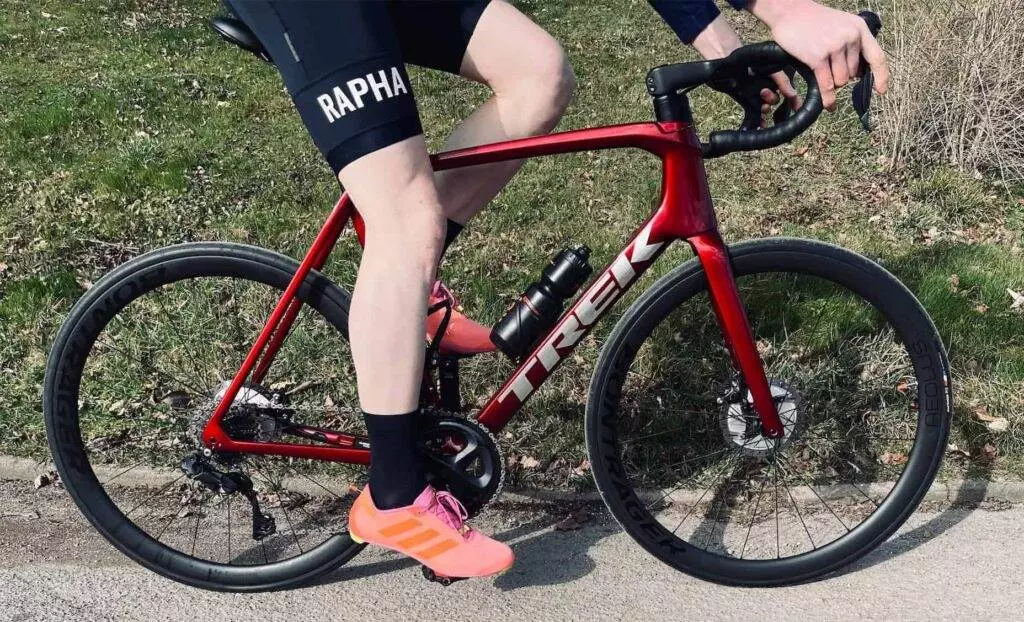
Quads
Your quad muscles are also known as the quadriceps femoris. They are the large mass of muscles at the front of your leg and the largest group of muscles in your body.
Your quads are responsible for movements like walking, jumping, and kicking, and they are the big guns in producing cycling power.
Sprinters and track cyclists have the largest quads.
Hamstrings
The hamstrings, or as we sometimes say, hammies, are a group of three muscles that run along the backside of your leg, from your hip to your knee.
These muscles are responsible for bending and straightening your knees.
If you sit a lot, your hamstrings may feel tight, but cycling can help. On the other hand, tight or underdeveloped hamstrings can lead to back pain on the bike.
Glutes
The glutes are the group of muscles that make up your backside. Glutes help you run, jump, sit, stand, and stabilize your joints.
On the bike, your glutes help you produce power and stability for cycling. Men more naturally engage their glutes, while women may need to work on this aspect off the bike.
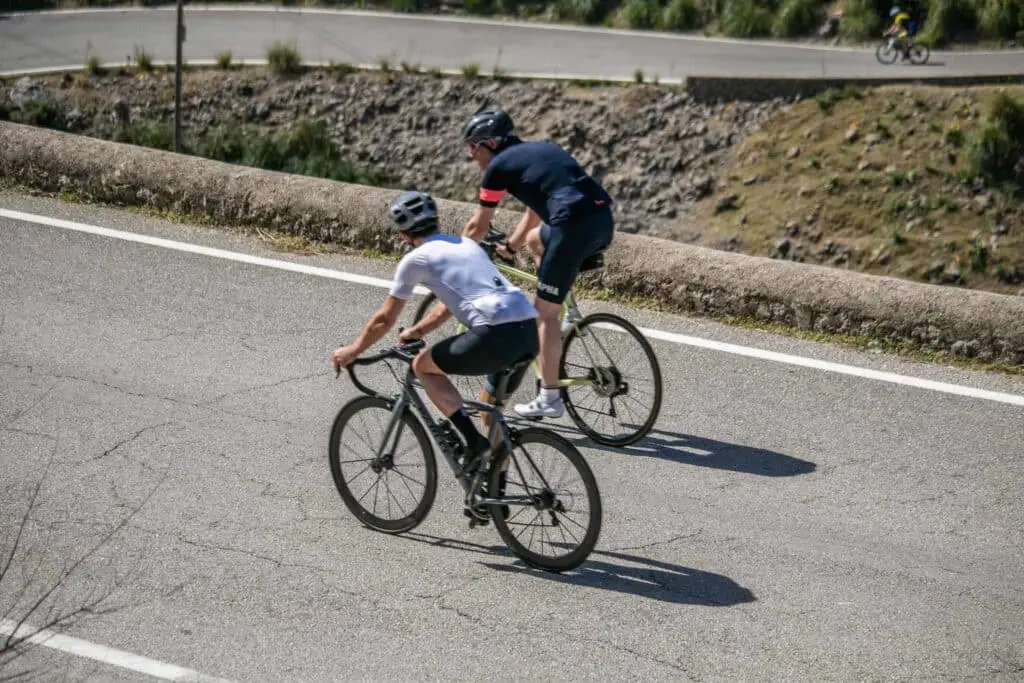
Calves and Shins
Your shins and calves also get a workout when you are cycling, and they help provide stability and power to the pedals. In addition, strong calves help protect your knees and ankles from injury.
Core Muscles
Your core muscles are important to cycling, too. Of course, they won’t get as much workout as your lower body, but you’ll still need to engage them as you ride.
Abdominals
Your abs come into play when you need to stabilize your upper body while riding. You probably don’t notice you’re using them unless they’re weak.
They’ll help keep you upright as you lean the bike to the corner. Strong abs will help you control the bike if you hit a pothole, ride over rough surfaces, or need to stop quickly.
If your abs are weak, you’ll probably use your hands and arms to hold your body off the handlebars.
You’ll notice this more on a road bike with an aggressive position than on a hybrid bike with a relaxed, more upright position. Weak abs can cause hand, shoulder, and neck pain.
If riding a mountain bike or doing CX, you’ll work your abdominal muscles as you shift your weight to keep the bike upright over obstacles.
The more you move your body on the bike, the more you use your abs while riding.
Erector Spinae
These are the deep muscles in the back that run alongside your spine. They help to keep you upright and enable rotation. In cycling, these muscles help to stabilize your upper body.
They’ll get a workout helping you bend, twist, and sit correctly on the bike, especially in mountain biking and off-road riding.
Other Upper Body Muscles
Cyclists often joke about their underdeveloped upper bodies and weedy, noodly arms. But you develop strength in your arms and upper body muscles as you ride.
It just won’t be as pronounced as your lower body.

Triceps
When I first started riding on gravel – I felt it in my triceps. Your triceps help to support your body weight, but if you feel them getting too fatigued, it might mean your bike fit isn’t right.
Also, ensure you aren’t locking out your elbows when riding.
Latissiums Dorsi
You might be surprised that cycling uses your lats. They won’t look like a bodybuilder’s lats, but they will get a workout as you push, pull, and turn your handlebars.
You’ll feel this more in mountain biking and cyclocross than in road cycling.
Is Cycling Good for Muscle Toning?
Cycling is an excellent exercise for muscle toning. It primarily targets the lower body muscles, including the quadriceps, hamstrings, calves, and glutes, which are all important muscles for improving overall strength and balance.
When cycling, the repetitive motion of pedaling helps activate and engage these muscles, leading to increased muscle tone and definition over time.
Additionally, cycling is a low-impact exercise that can be adjusted to different resistance levels, allowing you to increase the intensity of your workout and challenge your muscles further.
To see the best results, it’s recommended to incorporate cycling into a comprehensive fitness routine that includes strength training and a balanced diet.

Other Fitness Benefits of Cycling
In addition to improving cardiovascular health and aiding in weight loss, cycling offers numerous other fitness benefits.
Cycling is a low-impact exercise that is easy on the joints and can help to increase strength and endurance in the lower body.
It also engages the core muscles, including the abs and lower back, which helps to improve balance and stability.
Cycling can also be a great way to reduce stress and improve mental health, as it releases endorphins and provides an opportunity to spend time outdoors and enjoy the scenery.
Additionally, cycling can help improve flexibility and coordination, promote better sleep, and reduce the risk of chronic diseases such as diabetes and heart disease.
How Cycling Changes Your Muscles?
Cycling is an excellent exercise that engages several muscles, leading to significant muscle tone and strength changes.
The repetitive motion of cycling helps to build endurance in the leg muscles, including the quadriceps, hamstrings, and calf muscles.
These muscles are responsible for pushing down on the pedals, which requires significant effort over an extended period. As a result, regular cycling can lead to increased muscle size and strength in these areas.
In addition to the lower body muscles, cycling engages the core muscles, including the abs and lower back. These muscles help to stabilize the body and maintain good posture while cycling.
Over time, cycling can help to improve muscle tone in these areas, leading to a stronger and more stable core.
Cycling can also help develop the upper body muscles, including the arms and shoulders, as these muscles support the upper body weight and control the handlebars.
Cycling is a great way to improve muscle tone and strength throughout the body while providing an excellent cardiovascular workout.
Common Cycling Muscle Mistakes You Should Avoid
While cycling is a great way to build muscle and improve fitness, it’s essential to avoid common muscle mistakes that can lead to injury and discomfort.
One of the most common mistakes is not engaging the core muscles properly while cycling. Cyclists can experience back pain, poor posture, and reduced stability while riding without proper core engagement.
To avoid this mistake, keep your core muscles engaged throughout your ride by sitting upright, pulling your belly button towards your spine, and keeping your shoulders relaxed.
Another common mistake is relying too heavily on the quadriceps muscles while cycling. While these muscles are essential for powering the pedals, relying solely on them can lead to muscle imbalances and potential injury.
To avoid this mistake, focus on engaging the hamstrings and glutes, as these muscles work in conjunction with the quadriceps to power the pedals and stabilize the body while cycling.
Additionally, incorporating strength training exercises that target these muscles can help to build overall muscle balance and reduce the risk of injury while cycling.
Cyclists can enjoy a safer, more effective workout by avoiding these common muscle mistakes and focusing on proper form and muscle engagement.
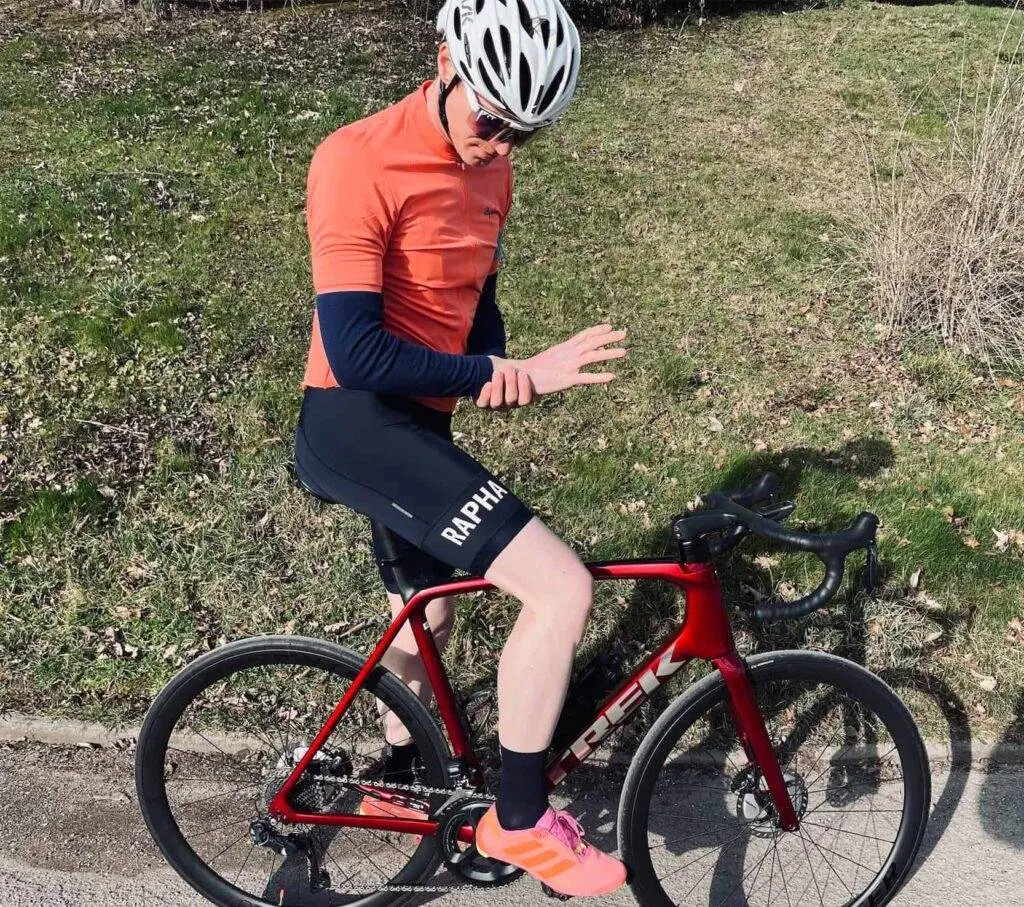
Male Vs. Female Cycling Muscles (Key Differences)
According to Cyclingweekly.com, men and women use their muscles on the bike differently. Men more naturally engage their core and glutes, whereas women must do off-the-bike work to make this happen.
Women use their quads more, but due to lower testosterone levels, they develop muscles much more slowly than men.
Men have more fast-twitch muscles, lean leg muscles, and higher hemoglobin levels. On the other hand, women have higher levels of body fat (they’re supposed to!) and more slow-twitch muscles.
This means men are 10 to 12% faster than women and more powerful. Women are typically lighter, more aerodynamic, and excel at endurance.
In addition, women’s bodies are more suited to burning fat, which takes longer but means they can use less fuel, too.
Cycling Muscles Vs. Running Muscles (How Do They Differ?)
Running uses more aerobic power than physical power.
So a typical runner is going to have leaner muscles. Running also uses the muscle groups in the legs more evenly, which gives runners more balanced, toned legs.
Cyclists, on the other hand, predominantly use quads and glutes. So a cyclist’s leg muscles will be more tear-drop shaped due to the larger quads and smaller calves.
There are exceptions, though. For example, in running, like cycling, sprinters will develop more powerful and, therefore, larger leg muscles than their fellow endurance runners and cyclists.
However, cycling sprinters are also heavier than endurance cyclists, so they’ll have a harder time with hill climbs.
On the other hand, in cycling, those specializing in hill climbing tend to have leaner, lighter muscles that are still very powerful.
Cross-training for running and cycling has about a 30% crossover, meaning running will have a 30% effect on your cycling training and vice versa.
The aerobic effects of running probably outweigh the muscle growth obtained from running.
What Muscles Cycling Works (Final Thoughts)
Cycling works almost all your muscles, although your power predominantly comes from the quads and glutes.
Although professional cyclists may have exaggerated lower bodies with smaller-appearing upper bodies, this won’t happen by accident or even with regular cycling.
On the other hand, any muscle imbalance can show up as pain while you ride. You may need to do off-the-bike work if you have pain and discomfort. And don’t forget to see a bike fitter, too.
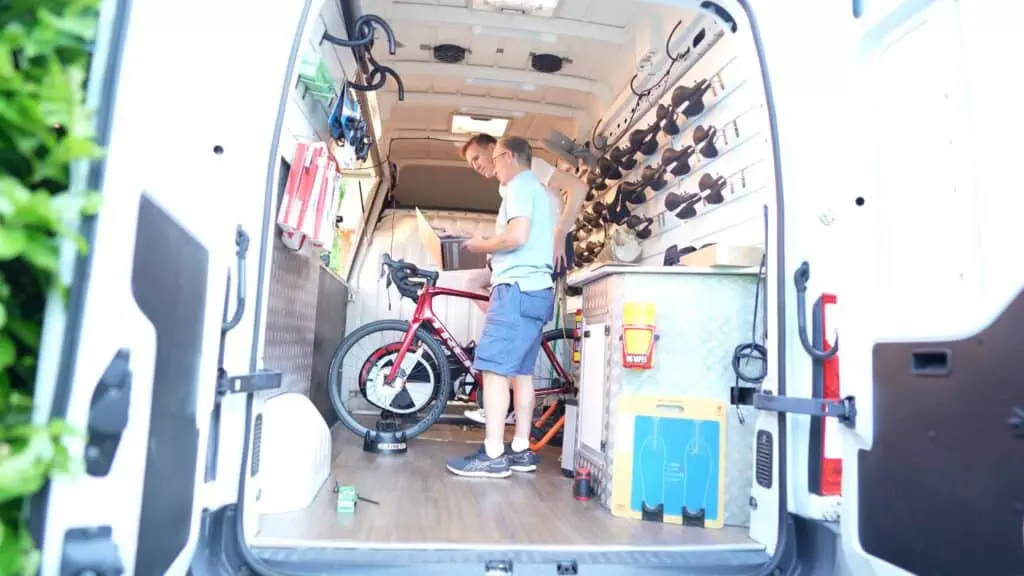
So although cycling does work your muscles, target weight training off the bike will help you in a number of ways.
- Weight training will correct muscle imbalances that can lead to inefficient pedaling.
- Weight training can protect against pain and injury. For example, weak abs can cause hand and shoulder pain, but you can prevent this injury by training the abs off the bike.
- Weight training trains your fast-twitch muscle fibers, which makes you more powerful.
- Weight training improves your metabolism and your body’s ability to use fuel.
With all the benefits of training on and off the bike, it seems like a balanced approach to cycling is the best way to get faster and stronger on the bike.
But, of course, you’ll want to consult your medical practitioner and a coach or trainer before you jump into a new exercise routine.
Cycling is a healthy exercise for your aerobic and muscle systems.
Do you agree that cycling is an effective way to tone muscles? We want to hear from you!
Leave a comment below and share your thoughts on what muscles cycling tones. Do you have any tips for others looking to maximize the muscle-toning benefits of cycling?
Join the conversation, and let’s inspire each other to achieve our fitness goals through this amazing sport!
Frequently Asked Questions:
Does cycling tone your stomach?
Cycling does work your abdominal muscles, but if you want six-pack abs, you’ll need to do both weight training and eat a healthy diet with a calorie deficit.
It isn’t always healthy to have a six-pack, though. Every body type is different.
Can you get toned just from cycling?
Most people need to balance cycling with a healthy diet to look toned. To increase the benefits, though, you’ll want to do off-the-bike strength training.
Weight training can improve metabolism, create bigger muscles, and help your cycling.
What parts of your body does cycling tone?
Cycling works your lower body the most, especially your glutes and quads. However, it also works for the other muscle groups in your body, such as your core and upper body, just not to the same extent.
Is 30 minutes of cycling a day enough?
According to the United States Center for Disease Control, healthy adults need:
150 minutes per week of moderate-intensity exercise and 2 days of strength training per week.
For example, 30 minutes of moderate cycling 5 days a week plus 2 days of strength training.
Why do cyclists have big bellies?
Abdominal fat can be caused by poor diet, overeating, or health conditions such as diabetes. Some cycling organizations are strongly associated with drinking alcohol, which can cause weight gain.
However, anyone can ride a bike! You don’t have to be skinny or have an ideal body shape to ride a bike and get stronger and faster.
Can cycling reduce love handles?
Cycling can be an effective way to reduce love handles, but it’s important to note that spot reduction is not possible. You can’t target fat loss in a specific body area, such as your love handles.
However, cycling is a great way to burn calories and increase your overall fitness level, which can help you lose weight and reduce body fat.
By combining regular cycling with a healthy diet and other forms of exercise, you can work towards reducing your love handles and achieving a more toned physique.
